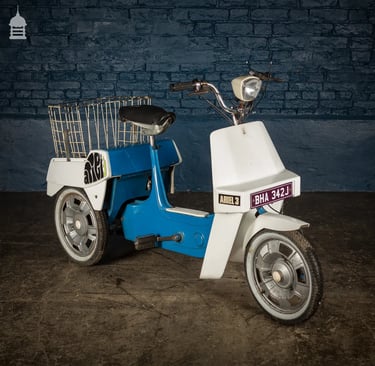The BSA Ariel 3 Moped: A Unique Innovation with a Mix of Failure and Licensing Success
The BSA Ariel 3 moped, introduced in the early 1970s, was a three-wheeler with pedal assist that aimed to provide riders with a practical and efficient means of transportation for urban commuting. Despite its innovative design, the moped faced several challenges that led to its commercial downfall, including consumer skepticism, limited performance, and a lack of market understanding. BSA decided to license the tilting three-wheeler concept to Honda, and the result was the Honda Gyro series, which became an integral part of Honda's urban mobility solutions. This licensing agreement allowed BSA to recoup some of its losses.
MOPEDS3 WHEELED MOPEDSUNITED KINGDOM 1970'STWO STROKEBSA
11/7/20233 min read


The BSA Ariel 3 Moped: A Unique Innovation with a Mix of Failure and Licensing Success
In the annals of motorcycling history, the BSA Ariel 3 moped stands out as a fascinating example of innovative engineering that faced both market failure and later licensing success. Introduced in the early 1970s, the Ariel 3 was a pioneering attempt to revolutionize the world of two-wheelers. This comprehensive article explores the story of the Ariel 3 moped, its standout feature - pedal assist, its struggles in the market, and the licensing success that followed.
The Ariel 3: A Unique Innovation
BSA, the British motorcycle manufacturer, was renowned for producing iconic motorcycles. However, in the early 1970s, they embarked on a new venture by introducing the Ariel 3 moped. What set the Ariel 3 apart from conventional mopeds was its radical design - a three-wheeler. It featured two wheels in the front and a single wheel at the rear. This configuration was quite unusual at the time.
Pedal Assist: One of the most distinctive features of the Ariel 3 was its pedal assist system. While it was powered by a small 49cc two-stroke engine, riders had the option to pedal like a bicycle to assist the engine's power. This unique combination of pedal power and a small engine was a forward-thinking concept that aimed to provide riders with a practical and efficient means of transportation. It was marketed as an ideal choice for urban commuting.
Market Entry: The Ariel 3 made its debut in 1970, and BSA had high hopes for its success. At a time when urban mobility was becoming a significant concern, the moped's compact size and stability were seen as potential game-changers. With its three-wheel stability and pedal assist feature, it aimed to appeal to a wide range of riders, including those who did not possess a full motorcycle license.
Market Struggles and Failure
Despite its innovative design and features, the Ariel 3 faced several challenges that led to its commercial downfall:
Consumer Skepticism: The unique design of the Ariel 3 initially piqued curiosity but also generated skepticism. Many riders were not accustomed to three-wheeled motorcycles, and the transition from a traditional two-wheeler was a significant hurdle.
Limited Performance: While the pedal assist was a unique selling point, the moped's performance was lackluster. The 49cc engine was not particularly powerful, and the pedal-assist feature was more of a marketing gimmick than a practical addition.
Lack of Market Understanding: BSA struggled to effectively market the Ariel 3. Potential buyers were not sure where this innovative vehicle fit into their lives, and the marketing campaigns failed to clarify its purpose.
Commercial Failure: These challenges cumulatively led to the Ariel 3's failure in the market. It did not receive the kind of reception that BSA had anticipated. The model's commercial failure led to financial troubles for BSA.
Licensing Success and Honda's Involvement
While the Ariel 3 moped did not succeed in the consumer market, its story took an interesting turn. Recognizing the innovative nature of the design, BSA decided to license the tilting three-wheeler concept to Honda.
Honda's Adaptation: After acquiring the rights to the innovative design, Honda further refined the concept and incorporated it into their product lineup. The result was the Honda Gyro series, which featured roofed tilting three-wheeler mopeds. This adaptation was more successful and became an integral part of Honda's urban mobility solutions.
Licensing Success: For BSA, licensing the concept to Honda turned out to be a lucrative move. The Ariel 3's unique design, which had faced rejection in the consumer market, found success through Honda's adaptations. This licensing agreement allowed BSA to recoup some of its losses.
Legacy and Lessons Learned
The Ariel 3 moped's story is a testament to the complexities of innovation and the unpredictable nature of market acceptance. It showcased that even groundbreaking ideas can face challenges if they are ahead of their time or poorly marketed. However, the story also highlights the potential for licensing success as a means to recover from initial failures.
While the BSA Ariel 3 moped may not have made a lasting impact on the world of motorcycles, its innovative spirit lives on through the successful adaptations made by companies like Honda. It serves as a reminder that the road to innovation can be filled with twists and turns, and sometimes, an idea's full potential is only realized through collaboration and adaptation.
